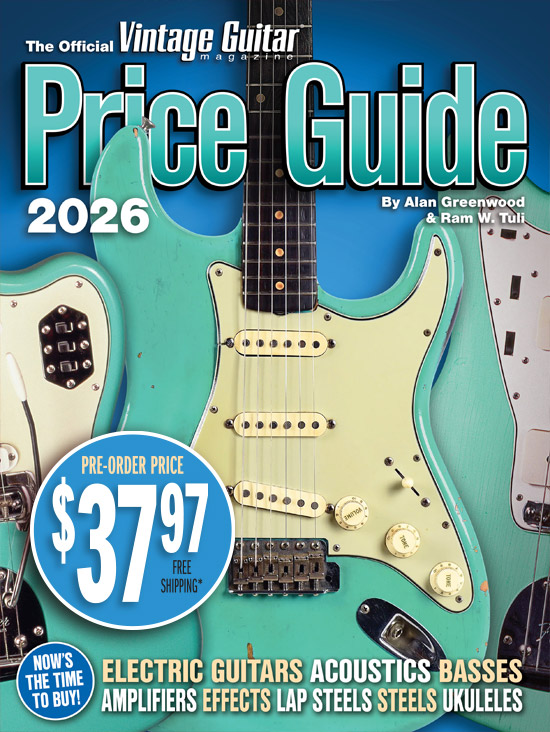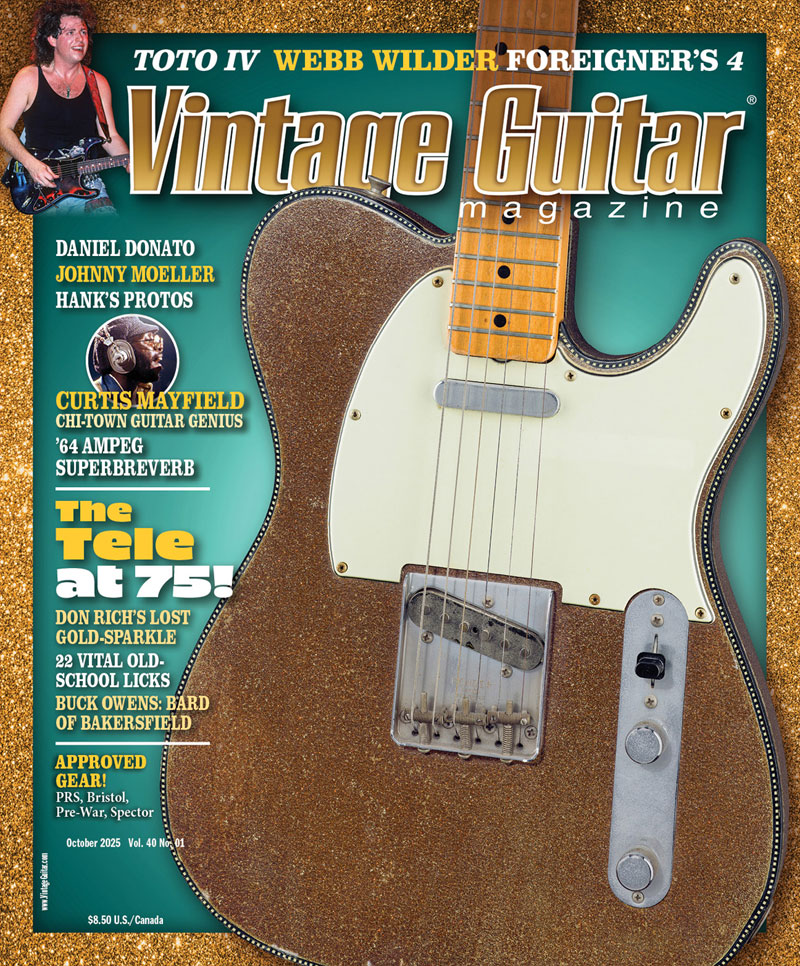
There’s no doubt the White Penguin is one of the rarest Gretsch instruments. It is estimated that no more than a few dozen were made from the introduction of the model in 1955 through 1964, when it was discontinued, though exact production totals for early Gretsch guitars are not available.
The Penguin appears in no Gretsch catalogs or literature other than the 1959 price list (in which it was offered for $490, while the White Falcon was $675) and a ’58 flyer, which mentioned the White Penguin along with the introduction of Project-O-Sonic stereo electronics, FilterTron pickups, space-control bridge with rollers to adjust string spacing, and the “neoclassical” fingerboard with “thumbprint” inlays.
List prices for White Penguins and White Falcons insured both would be extremely rare. By comparison, in 1958 and ’59, a sunburst Les Paul Standard with patent-applied-for humbucking pickups listed at $265 and the Les Paul Custom with three PAFs listed for $375. The Penguin, in spite of being cheaper than the Falcon, is extraordinarily more rare if only because it was not shown in catalogs and wasn’t promoted by the company to any significant extent. Original list price is not necessarily a determinant of current value on the vintage instrument market. New, the Penguin cost less than the Falcon, but today it’s much more rare, and viewed by many collectors as the holy grail of Gretsch instruments.
The Penguin and Falcon evolved in much the same manner. The Falcon featured body and neck dimensions the same as the Country Club model, with the exception of a larger and differently shaped peghead, while the Penguin featured Duo Jet-type structural features with the exception of the peghead. The Falcon and Penguin models shared ornamentation; with white finish, gold-sparkle edge trim, gold-plated hardware, Gretsch’s “Cadillac” tailpiece, and red rhinestones set into the volume knobs.
Early Falcons and Penguins featured hump-top block inlays with engraving, and the vertical gold-sparkle-inlaid Gretsch peghead logo with wings to the side. A metal armrest is typical of the Penguin, though some lack the feature. Early Penguins and Falcons have a Melita bridge, single-coil DeArmond pickups, one three-position toggle pickup selector, and a master volume knob on the upper bout, and two volume knobs and one tone knob on the lower bout.
In 1958, Gretsch introduced its FilterTron double-coil pickups, space-control bridge, and changed the wiring such that the Penguin and Falcon (and other Gretsches from that time onward) feature a three-position pickup selector and three-position tone switch on the upper bass bout, a master volume knob on the upper treble bout, and two volume knobs on the lower bout.
The Penguin shown here is a 1958 model featuring the early vertical peghead logo, “thumbprint” fingerboard inlays, and FilterTron pickups spaced in the Project-O-Sonic stereo position, with the middle pickup close to the rhythm pickup. However, this guitar is wired in mono. A couple of Project-O-Sonic stereo Penguins have been found, almost undoubtedly custom-order instruments. In fact, because the Penguin didn’t appear in Gretsch literature, it’s reasonable to assume that virtually all Penguins were custom orders.
While most Penguins appear to feature virtually the same electronic and ornamental specifications as Falcons of the same time period, the positioning of the lead pickup on Penguins with FilterTron pickups varied more than on most other Gretsches.
By late ’58, the vertical peghead logo was discontinued on the Falcon and Penguin, and the more typical horizontal Gretsch logo was introduced. Falcons and Penguins were also then fitted with a metal model logo and serial number plate on the front of the peghead, similar to that on the Country Gentleman. By ’62, the single-cutaway design was discontinued on the Penguin in favor of the new double-cutaway design introduced on the Duo Jet. The double-cut version of the Penguin is the rarest of all, though rarity, desirability, and market price are not necessarily linked.
The White Penguin is such a rare instrument that it’s difficult to apply to normal standards of supply, demand, and precedent in appraising them. However, there’s no doubt Penguins have commanded higher prices than any other Gretsch guitars, with some selling for more than $80,000. It’s especially noteworthy that this has been achieved in spite of the fact that not only is this model extremely rare, but with the exception of Dan Fogelberg, one would be hard-pressed to name any major artist who has made significant use of a vintage White Penguin onstage or in the studio. The appeal of the model is its extreme rarity and the fact that it was the most deluxe Gretsch guitar in this body size.

While the Penguin and its larger hollowbody companion are undoubtedly of as fine quality as any electric guitars ever made by Gretsch, functionally, a White Falcon is virtually identical to the much less expensive Country Club model, since the body size, neck shape, and electronics (and virtually all structural features that have anything to do with playability or sound) are the same.
Conversely, the Penguin is virtually identical to the Duo Jet, sharing the same body construction, neck dimensions (except for the peghead), and the same electronics and other structural components that would affect playability or sound. It’s therefore possible to get the same functional result from another Gretsch of the same era for a fraction of the cost. By contrast, it is not possible to get the sound of a Fender Telecaster or a Fender Stratocaster from a dramatically less expensive Fender guitar of the same era, nor is it possible to get the sound of a late-’50s Gibson Les Paul Standard, Flying V, or Explorer from a dramatically less expensive Gibson model from the same era.
The vintage collectibles market is not driven by utilitarian function alone. Just as an original Van Gogh, Rembrandt, or Picasso painting has no greater functional utility than many far less expensive paintings, but still brings a huge price, there’s more to the vintage musical instrument market than function alone. The Penguin and Falcon, however, are perhaps among the most dramatic examples of fretted musical instruments, either acoustic or electric, in which the ornamental appeal and rarity of the model push prices exceedingly beyond that of other models of virtually identical functional appeal made during the same era, by the same maker.
Learn more about George Gruhn at Gruhn Guitars.
This article originally appeared in VG’s February 2005 issue. All copyrights are by the author and Vintage Guitar magazine. Unauthorized replication or use is strictly prohibited.



